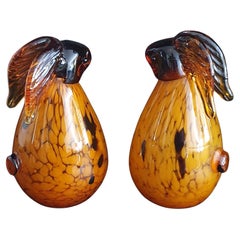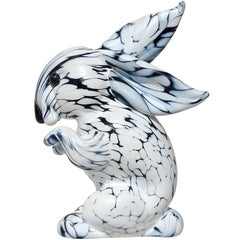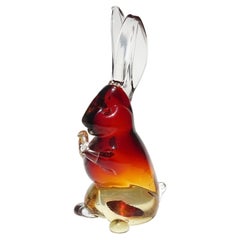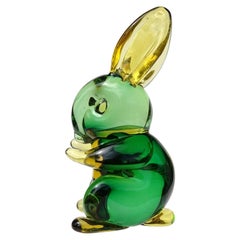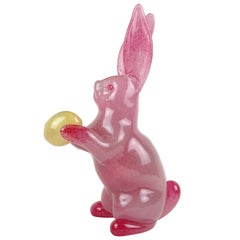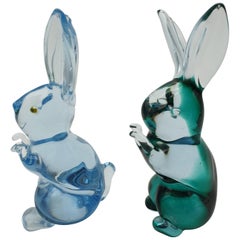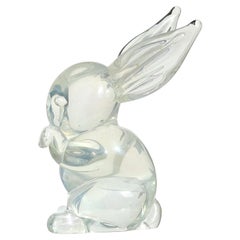Murano Glass Bunny
Mid-20th Century Italian Mid-Century Modern Animal Sculptures
Murano Glass
Vintage 1950s Italian Mid-Century Modern Animal Sculptures
Art Glass, Blown Glass, Murano Glass, Opaline Glass, Glass
Mid-20th Century Italian Mid-Century Modern Animal Sculptures
Glass, Art Glass, Blown Glass, Murano Glass
Mid-20th Century Italian Mid-Century Modern Animal Sculptures
Art Glass, Blown Glass, Murano Glass, Sommerso, Glass
Mid-20th Century Italian Art Deco Animal Sculptures
Art Glass, Blown Glass, Murano Glass, Sommerso, Glass
Mid-20th Century Italian Mid-Century Modern Animal Sculptures
Gold Leaf
Recent Sales
Vintage 1980s Italian Animal Sculptures
Murano Glass
Mid-20th Century Italian Mid-Century Modern Animal Sculptures
Glass, Art Glass, Blown Glass, Murano Glass, Sommerso
Mid-20th Century Italian Mid-Century Modern Animal Sculptures
Glass, Art Glass, Blown Glass, Murano Glass, Sommerso
Mid-20th Century Italian Mid-Century Modern Animal Sculptures
Art Glass, Blown Glass, Murano Glass, Sommerso, Glass
Mid-20th Century Italian Mid-Century Modern Animal Sculptures
Gold Leaf
Mid-20th Century Italian Mid-Century Modern Animal Sculptures
Glass, Art Glass, Blown Glass, Murano Glass, Sommerso
Vintage 1930s Italian Art Deco Animal Sculptures
Glass, Murano Glass, Sommerso, Art Glass, Blown Glass
Mid-20th Century Italian Art Deco Animal Sculptures
Art Glass, Blown Glass, Murano Glass, Sommerso, Glass
Mid-20th Century Italian Mid-Century Modern Animal Sculptures
Glass, Art Glass, Sommerso, Murano Glass, Blown Glass
Mid-20th Century Italian Mid-Century Modern Animal Sculptures
Art Glass, Blown Glass, Murano Glass, Sommerso, Glass
People Also Browsed
Mid-20th Century Italian Mid-Century Modern Animal Sculptures
Glass, Art Glass, Blown Glass, Murano Glass
Mid-20th Century Italian Mid-Century Modern Animal Sculptures
Art Glass
Mid-20th Century Italian Mid-Century Modern Animal Sculptures
Glass, Art Glass, Blown Glass, Murano Glass, Sommerso
Mid-20th Century Italian Mid-Century Modern Animal Sculptures
Gold Leaf
Mid-20th Century Italian Mid-Century Modern Animal Sculptures
Sommerso, Glass, Art Glass, Blown Glass, Murano Glass
Vintage 1940s Italian International Style Animal Sculptures
Murano Glass
Mid-20th Century Italian Mid-Century Modern Animal Sculptures
Glass, Art Glass, Blown Glass, Murano Glass, Sommerso
Mid-20th Century Italian Mid-Century Modern Animal Sculptures
Gold Leaf
Mid-20th Century Italian Mid-Century Modern Animal Sculptures
Glass, Sommerso, Murano Glass, Blown Glass, Art Glass
Mid-20th Century Italian Mid-Century Modern Animal Sculptures
Art Glass, Blown Glass, Murano Glass, Glass, Opaline Glass
Mid-20th Century Italian Mid-Century Modern Animal Sculptures
Sommerso, Art Glass, Glass, Murano Glass, Blown Glass
Mid-20th Century Italian Mid-Century Modern Animal Sculptures
Gold Leaf
Vintage 1950s Italian Mid-Century Modern Decorative Bowls
Gold Leaf
Mid-20th Century Italian Mid-Century Modern Animal Sculptures
Art Glass
Vintage 1970s Italian Mid-Century Modern Animal Sculptures
Art Glass, Blown Glass, Murano Glass
Mid-20th Century Italian Mid-Century Modern Animal Sculptures
Glass, Opaline Glass, Murano Glass, Blown Glass, Art Glass
Murano Glass Bunny For Sale on 1stDibs
How Much is a Murano Glass Bunny?
A Close Look at Mid-century Modern Furniture
Organically shaped, clean-lined and elegantly simple are three terms that well describe vintage mid-century modern furniture. The style, which emerged primarily in the years following World War II, is characterized by pieces that were conceived and made in an energetic, optimistic spirit by creators who believed that good design was an essential part of good living.
ORIGINS OF MID-CENTURY MODERN FURNITURE DESIGN
- Emerged during the mid-20th century
- Informed by European modernism, Bauhaus, International style, Scandinavian modernism and Frank Lloyd Wright’s architecture
- A heyday of innovation in postwar America
- Experimentation with new ideas, new materials and new forms flourished in Scandinavia, Italy, the former Czechoslovakia and elsewhere in Europe
CHARACTERISTICS OF MID-CENTURY MODERN FURNITURE DESIGN
- Simplicity, organic forms, clean lines
- A blend of neutral and bold Pop art colors
- Use of natural and man-made materials — alluring woods such as teak, rosewood and oak; steel, fiberglass and molded plywood
- Light-filled spaces with colorful upholstery
- Glass walls and an emphasis on the outdoors
- Promotion of functionality
MID-CENTURY MODERN FURNITURE DESIGNERS TO KNOW
- Charles and Ray Eames
- Eero Saarinen
- Milo Baughman
- Florence Knoll
- Harry Bertoia
- Isamu Noguchi
- George Nelson
- Danish modernists Hans Wegner and Arne Jacobsen, whose emphasis on natural materials and craftsmanship influenced American designers and vice versa
ICONIC MID-CENTURY MODERN FURNITURE DESIGNS
- Eames lounge chair
- Nelson daybed
- Florence Knoll sofa
- Egg chair
- Womb chair
- Noguchi coffee table
- Barcelona chair
VINTAGE MID-CENTURY MODERN FURNITURE ON 1STDIBS
The mid-century modern era saw leagues of postwar American architects and designers animated by new ideas and new technology. The lean, functionalist International-style architecture of Le Corbusier and Bauhaus eminences Ludwig Mies van der Rohe and Walter Gropius had been promoted in the United States during the 1930s by Philip Johnson and others. New building techniques, such as “post-and-beam” construction, allowed the International-style schemes to be realized on a small scale in open-plan houses with long walls of glass.
Materials developed for wartime use became available for domestic goods and were incorporated into mid-century modern furniture designs. Charles and Ray Eames and Eero Saarinen, who had experimented extensively with molded plywood, eagerly embraced fiberglass for pieces such as the La Chaise and the Womb chair, respectively.
Architect, writer and designer George Nelson created with his team shades for the Bubble lamp using a new translucent polymer skin and, as design director at Herman Miller, recruited the Eameses, Alexander Girard and others for projects at the legendary Michigan furniture manufacturer.
Harry Bertoia and Isamu Noguchi devised chairs and tables built of wire mesh and wire struts. Materials were repurposed too: The Danish-born designer Jens Risom created a line of chairs using surplus parachute straps for webbed seats and backrests.
The Risom lounge chair was among the first pieces of furniture commissioned and produced by celebrated manufacturer Knoll, a chief influencer in the rise of modern design in the United States, thanks to the work of Florence Knoll, the pioneering architect and designer who made the firm a leader in its field. The seating that Knoll created for office spaces — as well as pieces designed by Florence initially for commercial clients — soon became desirable for the home.
As the demand for casual, uncluttered furnishings grew, more mid-century furniture designers caught the spirit.
Classically oriented creators such as Edward Wormley, house designer for Dunbar Inc., offered such pieces as the sinuous Listen to Me chaise; the British expatriate T.H. Robsjohn-Gibbings switched gears, creating items such as the tiered, biomorphic Mesa table. There were Young Turks such as Paul McCobb, who designed holistic groups of sleek, blond wood furniture, and Milo Baughman, who espoused a West Coast aesthetic in minimalist teak dining tables and lushly upholstered chairs and sofas with angular steel frames.
Generations turn over, and mid-century modern remains arguably the most popular style going. As the collection of vintage mid-century modern chairs, dressers, coffee tables and other furniture for the living room, dining room, bedroom and elsewhere on 1stDibs demonstrates, this period saw one of the most delightful and dramatic flowerings of creativity in design history.
Finding the Right Animal-sculptures for You
Invite the untamed wonders of the animal kingdom into your home — and do so safely — with the antique, new and vintage animal sculptures available on 1stDibs.
Artists working in every medium from furniture design to jewelry to painting have found inspiration in wild animals over the years. For sculptors, three-dimensional animal renderings — both realistic and symbolic — crisscross history and continents. In as early as 210 B.C., intricately detailed terracotta horses guarded early Chinese tombs, while North America’s native Inuit tribes living in the ice-covered Arctic during the 1800’s wore small animal figurines carved from walrus ivory. Indeed, animal sculpture has a long history, and beginning in the 19th century, the art form started becoming not only fashionable but artistically validated — a trend that continues today. At home, animal sculptures — polished bronze rhinos crafted in the Art Deco style or ceramic dogs of the mid-century modern era — can introduce both playfulness and drama to your decor.
In the case of the frosted glass sculptures crafted by artisans at legendary French glassmaker Lalique, founded by jeweler and glass artist René Lalique, some animal sculptures are purely decorative. With their meticulously groomed horse manes and detailed contours of their parakeet feathers, these creatures want to be proudly displayed. Adding animal sculptures to your bookcases can draw attention to your covetable collection of vintage monographs, while side tables and wall shelving also make great habitats for these ornamental animal figurines.
Some sculptures, however, can find suitable nests in just about any corner of your space. Whimsical brass flamingos or the violent, realist bronze lions created by Parisian sculptor Antoine-Louis Barye are provocative and versatile pieces that can rest on windowsills or your desk. Otherwise, the brass cat shoehorns and bronze porcupine ashtrays designed by Viennese artist Walter Bosse are no longer roaming aimlessly throughout your living room, as they’ve found a purpose to serve.
Embark on your safari today and find a fascinating collection of vintage, modern and antique animal sculptures on 1stDibs.
- What is Murano glass?1 Answer1stDibs ExpertMarch 31, 2023Murano glass is colorful art glass primarily produced on Murano, an island in Venice, Italy. Artisans produce a variety of Murano glass decorative objects, including vases, lamps, candle holders, figurines, bowls and wine glasses. Shop a selection of Murano glass pieces on 1stDibs.
- Does Murano glass have markings?1 Answer1stDibs ExpertApril 5, 2024Yes, Murano glass is typically marked. You will usually find the markings on the bases of pieces or in other inconspicuous areas. Generally, Murano glass will display a trademark and a maker's mark, indicating which shop produced it. In most cases, authentic Murano glass will not have the word "Murano" on it. On 1stDibs, explore a selection of Murano glass.
- Does Murano glass break?1 Answer1stDibs ExpertApril 5, 2022Yes, Murano glass can break. Generally considered very durable, Murano glass is still made of glass and it is susceptible to breaks if it’s improperly handled or dropped. Known as some of the best glass produced in the world, unfortunately it can still break. On 1stDibs, find a collection of authentic Murano glass pieces from some of the world’s top sellers.
- How is Murano glass marked?1 Answer1stDibs ExpertFebruary 27, 2024How Murano glass is marked varies. Some pieces feature a label, sticker or other mark that bears the name of the studio that produced them. Others may only have an artist's signature or be unmarked. However, Murano glass artisans rarely put the word "Murano" on their pieces, though you will often see the word on replicas. For assistance determining whether a particular piece is Murano, consult an expert appraiser or antiques dealer. On 1stDibs, find a collection of Murano glass.
- What is Murano glass made of?1 Answer1stDibs ExpertApril 16, 2024Murano glass is made of a combination of materials. In most cases, artisans use a blend of silica, soda, lime and potassium to produce the colorful art glass. The mixture gets heated to a high temperature to melt it, so that glassblowers can form it into various shapes. On 1stDibs, find a selection of Murano glass.
- Where is Murano glass signed?1 Answer1stDibs ExpertApril 5, 2022Authentic Murano glass often, but not always, includes labels with the name of the workshop, the signature of the glass master and a certificate of authenticity. To best determine if a Murano glass is authentic, look up the location of the factory found on the label. All authentic Murano glass is produced in Venice or Murano. Always purchase Murano glass from a reputable seller to ensure authenticity. Browse a selection of authentic Murano glass pieces on 1stDibs.
- 1stDibs ExpertApril 5, 2022Murano glass, from the Venetian island of Murano, is world-renowned for excellent craftsmanship and a wide variety of colors and decorations. The glassmakers of Murano use methods honed over centuries to create rich colors and designs by mixing different minerals during the process. Many examples contain gold and silver flecks inside the glass. You’ll find a collection of authentic Murano glass from some of the world’s top sellers on 1stDibs.
- 1stDibs ExpertMarch 15, 2024Murano glass comes from Murano, an island located in the Venetian Lagoon to the north of Venice, Italy. Many people mistake the name Murano for that of a brand or company, but the term actually applies to glassware produced by a variety of makers. Fratelli Toso, Umberto Bellotto, the Salviati family, Ercole Barovier, Carlo Scarpa, Paolo Venini and Alfredo Barbini are just some of the glassblowers known for producing Murano glass. On 1stDibs, explore a wide range of Murano glass.
- How can I identify Murano glass?1 Answer1stDibs ExpertApril 5, 2022Murano glass is identifiable by its richly layered colors and characteristic gold or silver flecks inside the glass. Authentic Murano glass often has small imperfections and an irregular shape due to the freeform creation process. Find a collection of authentic Murano glass from some of the world’s top sellers on 1stDibs.
- Can Murano glass be clear?1 Answer1stDibs ExpertApril 5, 2022Although Murano glass is usually brightly colored, there are a few varieties of clear Murano glass. Cristallo glass, which is achieved by a process of bleaching, is a type of clear Murano glass. Shop a range of antique and vintage Murano glass pieces on 1stDibs.
- Is Murano glass valuable?1 Answer1stDibs ExpertJune 15, 2023Whether Murano glass is valuable depends on a variety of factors, including the type of piece and its condition. Artisans on Murano, an island in Venice, Italy, produce the colorful glassware through a unique process. Murano glass is identifiable by its richly layered colors and characteristic gold or silver flecks inside the glass. Authentic Murano glass often has small imperfections and an irregular shape due to the freeform creation process. One of the earliest Venetian glass furnaces is believed to have been established as far back as the 8th century (the filigrana technique is as old as the 16th century). A certified appraiser can help you determine the value and authenticity of a particular piece. On 1stDibs, shop a selection of Murano glassware.
- Is Murano glass worth it?1 Answer1stDibs ExpertSeptember 9, 2024Yes, many glass lovers believe that Murano glass is worth it. Murano glass is named for the Venetian island of Murano, where glassmaking has been practiced for centuries. The glass is made using a variety of artisanal processes and is identifiable by its richly layered colors and characteristic gold or silver flecks inside the glass. Every vintage Murano glass decorative object is unique. Authentic Murano glass often has small imperfections and irregular shapes due to the freeform creation process. However, whether or not it’s worth investing in Murano glass is totally subjective! At 1stDibs, we believe in buying what you love. Our shopping experience enables discovery and learning, whether you are a seasoned connoisseur or just beginning your collection. Find Murano glass and other art glass pieces on 1stDibs.
- Is Murano blown glass?1 Answer1stDibs ExpertMay 5, 2023Yes, Murano is blown glass. Artisans on Murano, an island in Venice, Italy, produce the colorful glassware through a unique process. Murano glass is identifiable by its richly layered colors and characteristic gold or silver flecks inside the glass. Authentic Murano glass often has small imperfections and an irregular shape due to the freeform creation process. One of the earliest Venetian glass furnaces is believed to have been established as far back as the 8th century (the filigrana technique is as old as the 16th century). On 1stDibs, shop a collection of Murano glassware from some of the world’s top sellers.
- 1stDibs ExpertApril 5, 2022Murano Aventurine is glass that has been decorated with a surface effect which resembles shimmering specks found in quartz. This technique was pioneered by Murano in the 17th century. On 1stDibs, find Murano glass products from top sellers around the world.
- Why is it called Murano glass?1 Answer1stDibs ExpertMarch 31, 2023It is called Murano glass because of its place of origin. During the 13th century, artisans on the island of Murano in Venice, Italy, became famous for producing colorful glassware. Find a range of Murano glass from some of the world's top sellers on 1stDibs.
- 1stDibs ExpertSeptember 28, 2021There is no real difference between Venetian glass and Murano glass. While both Venetian glass and Murano glass come from Murano Island, Venice is a more popular location than Murano, hence it is called widely as Venetian glass. You can use both search terms to find the best piece for you on 1stDibs.
- 1stDibs ExpertMay 5, 2023To tell if a bird sculpture is made of Murano glass, professionals recommend having an antiques dealer or Murano glass expert examine it. Otherwise, look for the signature of the artist or factory on the piece. Authentic Murano glass will often, but not always, include labels with the name of the workshop, the signature of the glass master and a certificate of authenticity. Use trusted online resources to determine if the maker's location is or was in Murano, in northeastern Italy. Seeing the word "Murano" on a glass decorative object doesn't mean that it is authentic. In fact, most genuine pieces won't show the word "Murano." Murano glass is identifiable by its richly layered colors and characteristic gold or silver flecks inside the glass. Authentic Murano glass often has small imperfections and an irregular shape due to the freeform creation process. Find a collection of Murano glass decorative objects on 1stDibs.
- 1stDibs ExpertApril 5, 2022To identify genuine Murano glass, first check for the certificate of authenticity. Sometimes, but not always, there will be a label with the workshop and the signature of the maker on the piece. Shop a collection of authentic Murano glass pieces from some of the world’s top sellers on 1stDibs.
- 1stDibs ExpertMay 5, 2023To tell if a glass rooster is Murano, you can look for markings and other details to try and determine the maker, but the best way to determine authenticity is to enlist the help of an antiques dealer or Murano glass expert. Otherwise, look for the signature of the artist or factory on the piece. Authentic Murano glass will often, but not always, include labels with the name of the workshop, the signature of the glass master and a certificate of authenticity. Use trusted online resources to determine if the maker's location is or was in Murano, in northeastern Italy. Seeing the word "Murano" on a glass decorative object doesn't mean that it is authentic. In fact, most genuine pieces won't show the word "Murano." Murano glass is identifiable by its richly layered colors and characteristic gold or silver flecks inside the glass. Authentic Murano glass often has small imperfections and an irregular shape due to the freeform creation process. Shop a collection of Murano glass pieces on 1stDibs.
- 1stDibs ExpertMay 5, 2023Whether Murano glass holds its value depends on a variety of factors, including how well it’s cared for as well as demand and supply. Antique Murano art glass can fetch thousands of dollars at auction depending on the brand, the history of the work, the technique used to design the piece and more. The first step in determining if your Murano glass object has held its value is determining its authenticity. To tell if a Murano glass vase is real, look for the name of the shop that produced it on the bottom. Then, use trusted online resources to determine if the workshop is in Murano, Italy. Bear in mind that authentic pieces normally do not have the word "Murano" on their labels. If you need assistance authenticating a particular vase, you may wish to enlist the help of a certified appraiser or experienced antiques dealer. Because it can be difficult to predict how the value of items will change over time, choose decorative objects that appeal to you. On 1stDibs, shop an assortment of Murano glassware from some of the world’s top sellers.
Read More
How Noguchi Elevated Ashtrays to Objets d’Art
Smoking might have fallen out of fashion, but these ashtrays have enduring design appeal.
Jeff Andrews Captures Old Hollywood Glamour in His Cinematic Spaces
Having created extravagant homes for reality TV’s biggest stars, the designer is stepping into the spotlight with his first book.
Tapio Wirkkala Bucked the Trends of Mid-Century Nordic Design
The Finnish talent created nature-inspired pieces, from furniture to jewelry, with phenomenal staying power.
